It’s often forgotten, but a machete can come in handy in many wilderness situations. Under review today is the Gerber Gator Machete.
Machetes
I own several machetes of different sizes and from different companies. Some came without a package, so I have no idea who made them, other than to guess that they were made in China, as is this Gerber Gator Machete. All of my machetes are rusted. They are all manufactured out of carbon steel, and all were fairly inexpensive. However, they all work.
Gerber
I’ve been a fan of Gerber products for a lot of years, and it wasn’t all that many years ago that all of their products were made in the good ol’ USA! Such is not the case these days. In order to compete with other knife companies, some of Gerber’s products are made in China. This machete is no exception, and it was difficult to find the tiny print on the package that stated it was made in China.
Specs on the Gator Machete
Some of the specs on the Gator Machete are that it is made out of forged carbon steel and has an 18-inch blade. The blade itself is 18 inches long and is 2.4 inches at its widest point. Also, it weighs in at slightly more than a pound. The saw back portion of the blade is about 15 inches. I love the Gator Grip rubberized handle; it’s outstanding. There is also a lanyard hole with a lanyard attached. A heavy duty nylon sheath that is riveted is included as well. There is also a limited lifetime warranty on this product.
Brush Clearing by Hand With a Machete
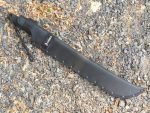 The statistics on the Gator Machete are pretty impressive, to say the least. However, the proof is in the testing. Much of my small homestead is very hard to get through with so much under- and over-growth and lots of trees, big and small. I really need to hire someone to clear a lot of the brush with a front-end loader, a big one. A friend tried some brush clearing with his front-end loader, but the landscape got the better of his machine, and it was bogged down. I do some brush clearing by hand with a machete!
The statistics on the Gator Machete are pretty impressive, to say the least. However, the proof is in the testing. Much of my small homestead is very hard to get through with so much under- and over-growth and lots of trees, big and small. I really need to hire someone to clear a lot of the brush with a front-end loader, a big one. A friend tried some brush clearing with his front-end loader, but the landscape got the better of his machine, and it was bogged down. I do some brush clearing by hand with a machete!
Price
My local small box store had advertised this Gerber Gator Machete for $9.97 with the nylon sheath. (The regular price is ten bucks more.) Checking on the ‘net, I’ve seen this same identical machete selling for as much as $30, and Gerber has it on their website for $23. So, the price is all over the place.
Machete Blade
Many people don’t understand the characteristics of a machete’s blade. They believe they are supposed to come with a razor-sharp blade. The reality is far from it. It has a “working edge”, and that means the cutting edge is thicker than the edge you’ll find on a knife. If the edge is too thin, it will chip and fold over when you encounter heavy brush or small trees as you are chopping or clearing land. Also, a machete’s blade is soft, so it will flex rather than break.
Gator Grip Rubberized Handle
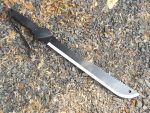 First up is the outstanding gator grip rubberized handle. It is fantastic! Under any weather conditions, you don’t have to worry about this machete slipping out of your hands. This is very important when swinging such a long blade. The rubberized material grips you back. It’s just that simple. I like the lanyard on the handle as well; it comes in handy.
First up is the outstanding gator grip rubberized handle. It is fantastic! Under any weather conditions, you don’t have to worry about this machete slipping out of your hands. This is very important when swinging such a long blade. The rubberized material grips you back. It’s just that simple. I like the lanyard on the handle as well; it comes in handy.
Saw on Back of Blade
The saw on the back of the blade, like many saws on cutlery, is about useless. If you try to saw through anything except the smallest branch on a tree, it just doesn’t work. Be advised right up front. I would rather not have this feature on a machete, period!
Testing
I did quite a bit of testing with this Gerber Gator Machete. We never lacking anything that needs to be chopped down, especially blackberry vines. To be sure, we have some really thick blackberry vines, and you don’t want to get too close to them. They seem to reach out and grab your skin or clothing, and I’m not kidding. When swinging the machete against blackberry vines, or even using a knife, the idea is to cut them on an angle, not straight across the vine. Every super-thick blackberry vine I cut down with the machete was cut cleaning through. There is never a lack of blackberry vines on our small homestead.
Those blackberry vines are appreciated in late summer and early fall. It calls for lots of blackberry picking, but it is well worth it. There’s nothing like picking fresh blackberries, and then a couple hours later my wife is pulling a freshly-made blackberry cobbler out of the oven. It doesn’t get any better than that. Plus, the wife loves blackberry syrup on her pancakes, too, which is easy to make as well. Free food is always welcomed, and we can pick all the blackberries we want. It’s lots of work but worth it.
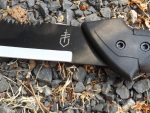 I used the Gator Machete on some small tree branches that were starting to cover my driveway alarms, causing lot of false alarms, and I had no problem at all using the machete. I challenged the blade against some larger tree branches, and it just wasn’t worth the effort. The saw back feature, as already mentioned, is useless. Some undergrowth was cleared with the machete. It does take a lot of work clearing a path. Ever watch any jungle movies where they easily just swing their machetes and clear a path? Well, it doesn’t work quite that well, ever!
I used the Gator Machete on some small tree branches that were starting to cover my driveway alarms, causing lot of false alarms, and I had no problem at all using the machete. I challenged the blade against some larger tree branches, and it just wasn’t worth the effort. The saw back feature, as already mentioned, is useless. Some undergrowth was cleared with the machete. It does take a lot of work clearing a path. Ever watch any jungle movies where they easily just swing their machetes and clear a path? Well, it doesn’t work quite that well, ever!
Properly Use a Machete
Prior to starting this article, I checked the Gerber website to get the official stats on this blade. While there, I decided to look at the many reviews. Sadly, many of the reviewers gave mostly negative reviews. It’s sad but many people don’t seem to know how to properly use a machete. It can be a great survival or camp tool, when used properly. A machete is not an axe, so don’t use it as one. Many reviewers complained than the edge chipped, and some even said the edge easily bent or rolled over. I didn’t experience this in my testing.
Not Bad for the Money
I believe the Gerber Gator Machete is on the lower end of a quality machete. I’m not saying it’s a bad product. For the money, it’s a great product. However, I’d buy something a little more heavy duty, if I were buying it for survival purposes. For my own use around my homestead, it will do a lot of the chores I expect it to do. However, if packing one in a BOB, I’d elect to have a little bit better quality machete. As they say, you get what you pay for. I paid $9.97 for this machete. It is a decent, though not great, cutting/chopping tool. I’ll probably toss it in the bed of my pickup, just to have it there, along with some other outdoor tools, like emergency shovels.
A Conditional “Buy” Recommendation
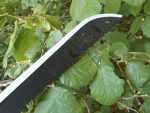 I’m a little disappointed in the fact that Gerber didn’t demand a little better quality in this machete that has the Gerber name on it. As stated, it’s not a bad machete, but I was expecting a little better quality from Gerber. It’s a conditional “buy” if you ask me. Don’t pay $30.00 for one. If you find one for under ten bucks, like I did, then buy it. However, it’s not worth the retail price of $23, in my humble opinion.
I’m a little disappointed in the fact that Gerber didn’t demand a little better quality in this machete that has the Gerber name on it. As stated, it’s not a bad machete, but I was expecting a little better quality from Gerber. It’s a conditional “buy” if you ask me. Don’t pay $30.00 for one. If you find one for under ten bucks, like I did, then buy it. However, it’s not worth the retail price of $23, in my humble opinion.
I rarely review products of “lesser” quality for our readers. However, in this case, as I stated, it is a conditional buy. Just don’t expect it to do the same things high-quality machetes will do.

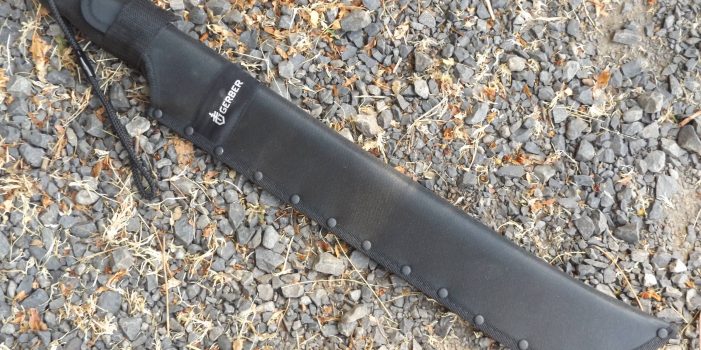









Might want to look at a Brazilian Tramontina. Less than $15 from Amazon and designed to work.
I agree, I own 4 Tramontina’s, 24″ is my favorite, they are well made and have the weight behind the swing to do any job. I own a lot of different machetes and IMHO Tramontina is the only way to go.
Tramontina!
In Canadian winters, blazing trails through the woods requires a pretty strong blade. It took ALOT of experimentation to get something that would hold up to cutting branches on spruce and pine (the resin stiffens in the cold and makes them pretty tough).
I own and use the Gerber model, but the one that won my respect was the Cold Steel Magnum Kukri, which is a Gurkha modelled style. it works flawlessly in the cold and has resisted damage to the cutting edge or bending. The only downside to the Cold Steel Kukri is the scabbard which requires the side sheathing and draw (awkward and could lead to an accidental injury).
The Cold Steel runs in the rough price range of the Gerber. I bought a few for family members who also work in the woods.
I’m very satisfied with my .230 TOPS Machete. Micarta handle with liners, blade coated, bungee style hand strap, Made in the USA.
Gerber had better get it’s act together or we will be “remembering it fondly” thirty years from now.
LOL, I *just* gave one of these Gerbers away last night during a White Elephant gift exchange at a Christmas party. The exact model discussed in the article. The guys all fought for it, and the eventual winner (after the obligatory stealing) was happy that he was going home with something that looked cool. Of course, it was the top-coveted gift only because this was the first year nobody brought actual ammo. True story!
I gave it away instead of keeping it because of the very reasons the author mentioned. Good for laughs and grabs for a White Elephant exchange, but that’s about it.
I have 4 of that model, I use the one on my polaris ranger routinely and cut up to and through 6 inch green limbs on my trails. I love them. Price is great at academy sports and outdoors store. Sheath is a big plus too.
Per previous comment on Cold Steel machetes. They have a wide selection, and I think pretty highly of them, but I have a big caveat. Especially if you buy off Amazon or from anyone besides Cold Steel (or my preferred vendor – their bargain basement clone “Lynn Thompson Special Projects”), you may have to do considerable work on the edge. They seem to have had a quality control problem some years back and those versions are still available on third party vendors.
I have really enjoyed the Ka-Bar Kukri machete over the last 5 years (the cutlass version is very good as well). It is probably a bit short for bushwacking through jungles, but it excels at clearing brush up to thumb-size in diameter. With a quick wrist flip, the heavy kukri blade does the rest! It holds a very sharp edge well, and comes with a nice leather sheath (at least mine did). The blade coating has prevented rust, but I baby mine, with a nice wipe-down and oiling after each use. Oh, and you can chop with this one, though would prefer an axe if available. Last time I looked, they were around $50 – not cheap, but I feel that it’s worth it. I have one in the shed, and one in each car.
Merry Christmas Y’all!
I’ve got an original Collins Mk1 U.S. Navy model made in 1941. Still cuts pretty much anything I swing it at. Sharpen it with a smooth bastard file when it gets a little dull. I’ll probably pass it on to my grandson when he gets a little older.
I use a Woodman’s pal, not cheap but it does all I want it to do.
Recent article about Central America mentioned machetes,coincidence? May make a excellent defensive weapon or barter item. Have been satisfied with a us mil surplus with self sharpening sheath.